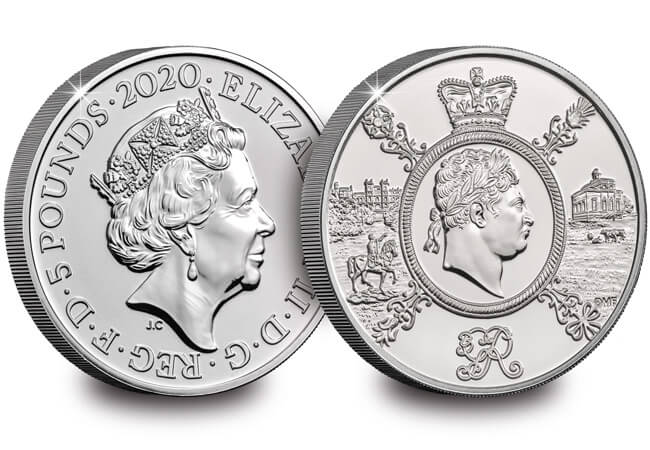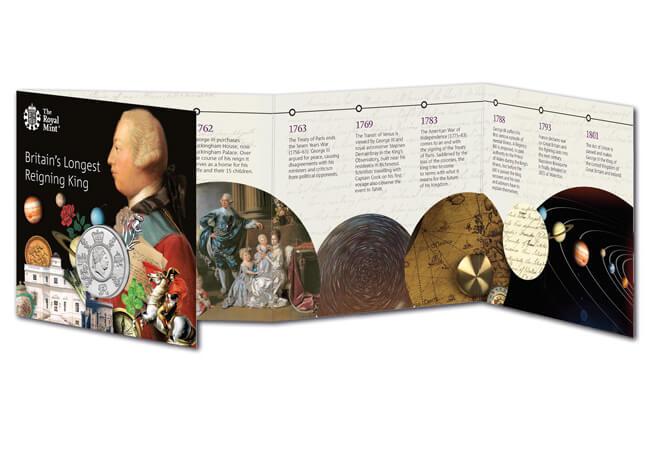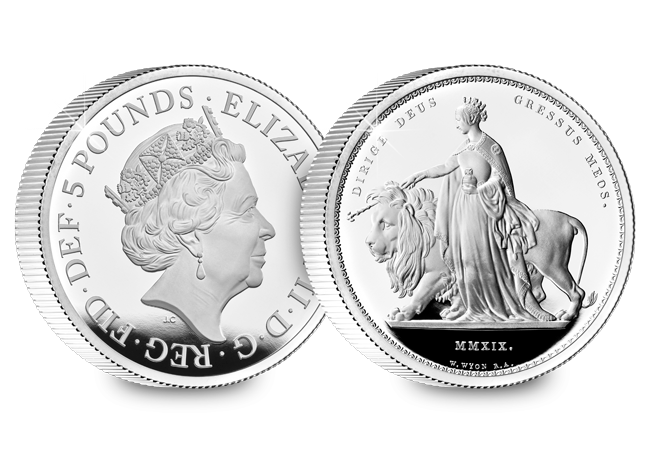Posts Tagged ‘EIC’
Celebrating the most iconic coins of King George III’s reign
On 29th January 2020 we marked the milestone 200th anniversary of the end of King George III’s reign. And whilst some will remember him as the ‘Mad King’, there is no denying the coins issued during his reign are some of the most iconic to have ever graced the pockets of the British public.
To celebrate his legacy some of the world’s most renowned Mints have issued some remarkable coin issues.
I’ve picked out some of my favourite designs to share with you today so you, too, can have the joy of discovering the most beautiful coins issued during King George III’s rule.
2020 UK King George III £5 BU £5
In 2020, to mark the 200th anniversary of King George III’s death, The Royal Mint issued this £5 coin.
Struck to a Brilliant Uncirculated finish, this coin features a design by Dominique Evans which explores the multifaceted nature of Britain’s longest reigning king. The design incorporates an effigy of the king alongside the King’s Observatory and Windsor Castle.
King George III’s impressive 59-year reign was memorable for multiple military conflicts, including the end of the American War of Independence and the defeat of Napoleon in the Battle of Waterloo. He oversaw great change in Britain as we emerged as a world power, and was even the first monarch to appear on the modern Sovereign!
I’m sure you’ll agree that this is a stunning issue. Do you have this coin in your collection? Let us know in the comments below.
St George and the Dragon
Designed by renowned engraver Benedetto Pistrucci, the St George and the Dragon design is probably one of the most instantly recognisable motifs in numismatic history. The design first appeared on the modern Sovereign in 1817, when it was struck to replace the gold Guinea following the Great Recoinage Act of 1816, and it still appears on today’s Sovereigns. This made King George III the first monarch to appear on the modern Sovereign, so it’s only fitting really that he is commemorated on a new range of Sovereign coins.
Pistrucci’s iconic design also appeared on King George III’s 1818 Crown, the first type of Crown or Five Shillings to be issued in his reign. This Crown was the first ‘new’ Crown coinage to be struck, and significantly only 155,000 were ever minted – making it highly sought-after amongst collectors today.
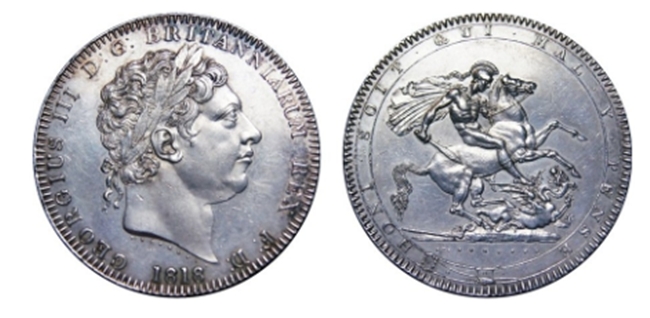
(Image courtesy of JN Coins, http://www.jncoins.co.uk/Shop/milled-crowns/702-george-iii-silver-crown-1818-lix.html)
The East India Company have struck a beautiful interpretation of this timeless design on the most prestigious Sovereign denomination – the Five Sovereign. The spectacular scene is framed by the Latin motto “hoit soit que mal y pense”, which translates to “shame on him who thinks evil of it” – the motto of the British chivalric Order of the Garter.
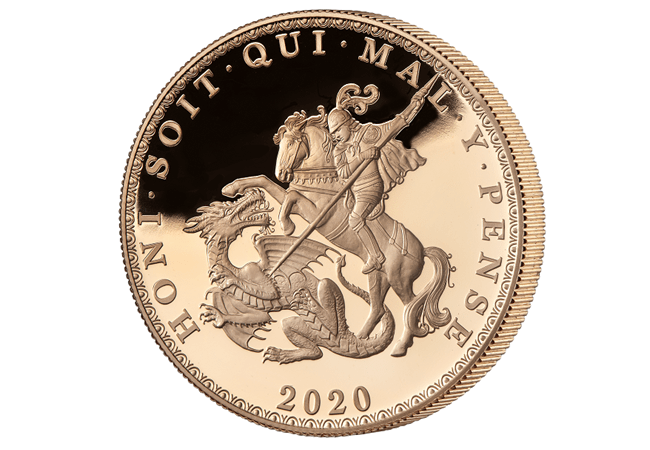
‘Counter Stamped’ Spanish Dollar
The cost of the French Revolutionary Wars, combined with the threat of invasion on the Welsh and Irish coasts, took its toll on the Bank of England resulting in members of the public demanding to withdraw large sums of cash. The result was a currency crisis, as the panicked public depleted the coin and bullion reserves of the Bank of England.
One thing was clear, a solution to the gold and silver coin shortage had to be found, and quickly. At the time most of the Bank’s reserves were held in the most popular coin of the time – Spanish Dollars. To fix the currency crisis King George III authorised the counter stamping of these Spanish Dollars with a ‘puncheon’ of the King’s head as part of the hallmarking. These modified dollars were released rapidly into the market, allaying the currency crisis.
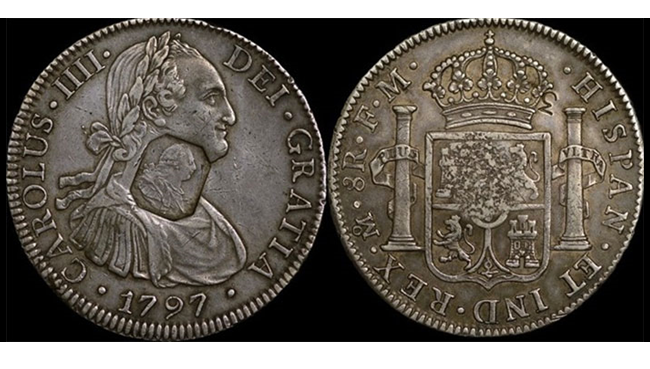
(Image courtesy of coinweek.com, https://coinweek.com/dealers-companies/ma-shops/coinweek-sponsor-amazing-uk-coins-on-ma-shops/)
In tribute to this iconic coin, the East India Company has replicated the design on a Double Sovereign piece. The reverse features an effigy of King Charles III of Spain inset with the effigy of King George III to represent the same process as the original Spanish Dollar coins.
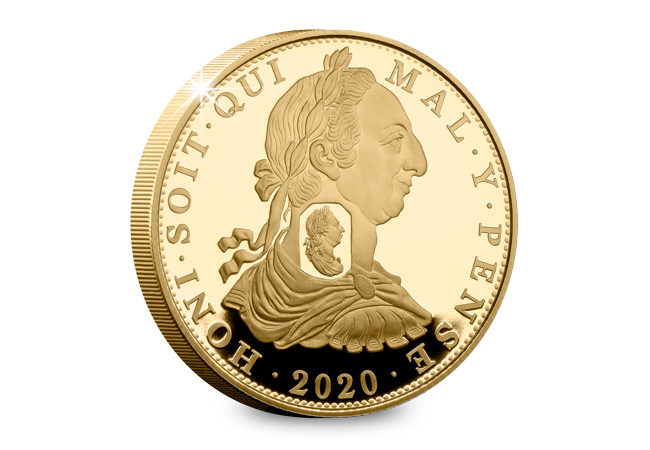
Spade Guinea
Under King George III’s reign Britain witnessed the Great Recoinage Act of 1816, following which the favoured gold coin of the time, the Guinea, was replaced by the Sovereign. This was a huge moment for Britain in terms of its currency as the Guinea had become the very foundation of the British Empire’s growth during the late 17th and 18th centuries. Had the Guinea remained in use it would have been circulating at the time of Wellington’s victory at Waterloo!
In its heyday several different motifs featured on Guineas, but none is as famous as the Spade Guinea. Nicknamed because of the spade-like shield on its reverse, this design featured on the last ever circulating Guinea during King George III’s reign.
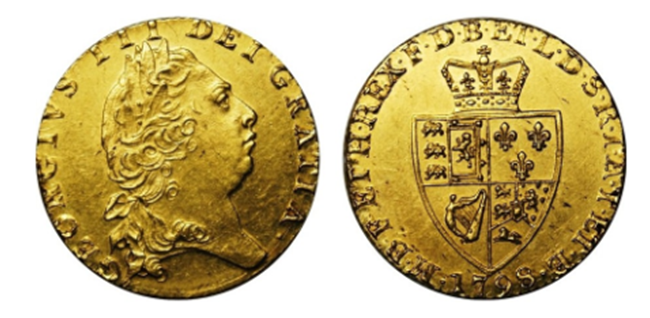
(Image courtesy of JN Coins, http://www.jncoins.co.uk/Shop/milled-gold/118-george-iii-spade-guinea-1798.html)
In fact, this is the only Guinea to feature this distinctive reverse design, and the Half Guinea issued in the same era is the only Half Guinea to also feature it. This makes the Spade Guinea one of a kind. It is this fact which makes the coin fascinating to collectors and historians alike.
Although the Guinea is no longer in circulation you may still come across its name from time to time in classic horse racing. The longstanding tradition of livestock being traded in Guinea values still exists in some auction houses and horse racing organisations because the name ‘Guinea’ is so intrinsically linked with the ‘sport of kings’.
And now this iconic design has been faithfully replicated on a Sovereign, issued by the East India Company. It represents England, Scotland, France and Ireland, as well as the German possessions of the Hanoverian dynasty.
Secure the 2020 UK King George III £5 BU Pack
Available to own in official bespoke Royal Mint presentation packing, the 2020 UK King George III £5 coin has been struck to a superior Brilliant Uncirculated quality.
Secure this bespoke presentation for your collection for just £13.00 (+p&p) by clicking here >>
The blend of fact and fiction that resulted in the world’s most beautiful coin
Storytelling is one of humanity’s oldest pastimes, with events being captured and passed on for centuries though art, music and dance long before we were writing them down. And one of the oldest and most reliable ways a country can tell its stories is through its coins.
This should come as no surprise. If you think about it, currency is the constant that has always been around in one form or another. It’s continually evolving and adapting to the next chapter in the story.
But there’s one coin in particular that holds more meaning than most – as it blends fact with fiction to produce the world’s most beautiful coin, Una and the Lion.
Controversial, yet beyond improvement
In 1839 William Wyon was commissioned to design a new coin to commemorate the anniversary of Queen Victoria’s coronation.
But it made headlines. It was controversial.
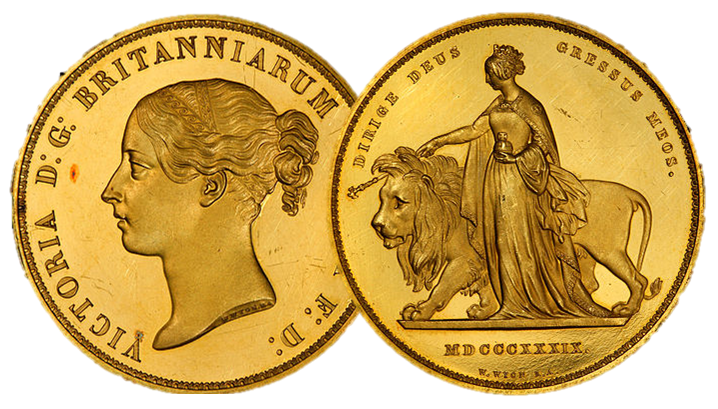
In a bold move it depicted Queen Victoria as the fictional character Lady Una, from Edmund Spenser’s epic poem The Faerie Queene. Never before had someone, let alone a ruler, been featured on a coin as a fictional character.
The design shows Lady Una walking alongside her guardian and symbol of England, the lion. It is symbolic of the young monarch leading her vast empire.
Whilst a daring move, the coin was an instant success. Critics hailed it as “beyond improvement”, and to this day it’s regarded as one of the most beautiful coins to have ever been struck.
Part of its beauty was the high relief, providing exquisite intricate detail to the fictional design. But in many ways this was also its downfall, as it meant the coin could not be struck with any consistency. As a result the commemorative was only struck for one year, producing just 400 coins. This makes it extremely rare!
The inspiration: a princess and her protector
Published in 1590, The Faerie Queene, is one of the longest and most distinguished poems in the English language. It was written during the height of the Renaissance when England had just broken away from the Catholic Church and formed its own Protestant Church. Set against the backdrop of this turbulent religious landscape, The Faerie Queene draws on history and myth to deliver numerous tales of romance, adventure, battles, morality and religion.

The first book of the epic poem follows the trials and tribulations of Lady Una – the young and beautiful daughter of a king and queen who have been imprisoned by a ferocious dragon. In a bid to save her parents she embarks on a quest, but on her journey she encounters a fierce lion who plans to eat her.
In a twist of events the lion is so captivated by Una’s beauty and innocence that he abandons his plans to eat her, and instead he becomes her protector and companion.
Together, the iconic pair have become a symbol of beauty, strength and endurance.
The most beautiful coin just became even more exquisite
The Royal Mint has just released a brand new UK Una and the Lion 2oz Silver Proof coin, featuring this iconic and highly sought-after design motif.
Finding an original Una and the Lion coin is virtually impossible, so this may be one of the only ways to secure this design motif for your own collection.
But with an edition limit of just 3,000 worldwide, there aren’t many available for collectors.
As an official Royal Mint distributor, we have secured a limited number for Westminster collectors.
Click here to find out more and add this iconic coin to your collection >>
Discover the coins that built the British Empire
The East India Company is living proof of Sir Walter Raleigh’s (1614) prophetic words: “whosoever commands the sea, commands the trade, whosoever commands the trade of the world commands the riches of the world and consequently the world itself,” as they rapidly became a trading force to be reckoned with.
And coins were one of the key ways the company managed trade across the globe.
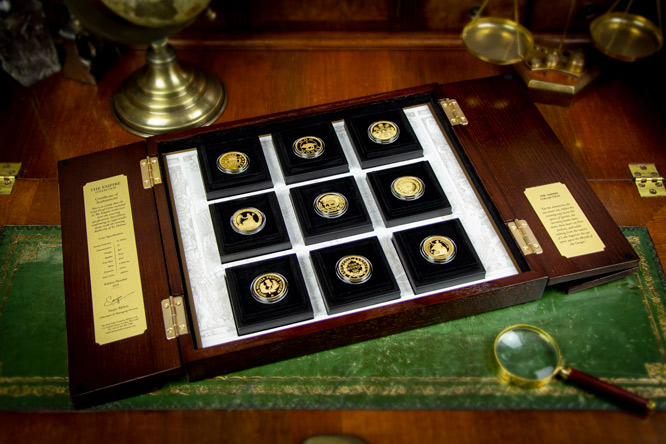
At its peak the EIC was single-handedly responsible for half the world’s trade, including cotton, silk, spices, opium and tea.
Remarkably, the East India Company is still trading today. And they have just authorised a set of limited edition Gold coins paying tribute to the most important coins in their history.
Here is the story behind the coins…

Portcullis Money – 1601 (Throughout the Empire)
Ordered by Queen Elizabeth I to facilitate increased commerce on behalf of the British Crown and to compete against the widely used Spanish Real. These were the first coins issued for the British Empire outside of England’s normal coinage.
The Cartwheel Penny – 1797 (Australia)
The Cartwheel Penny was the first British coin to be exported to Australian Colonies. It was introduced to help curb Britain’s chronic coin shortage which was impacting economic growth. Specially designed to prevent counterfeiting, and the thick rim and inscription led to the pennies being informally named ‘The Cartwheel Penny’.
The Elephant and Castle Guinea – 1663 (Throughout the Empire)
The guinea is regarded as the most successful trade coin, exponentially increasing British and local trade wherever it was introduced. This Guinea was the first British machine-struck coin, and adopted its name from where the gold was mined from.
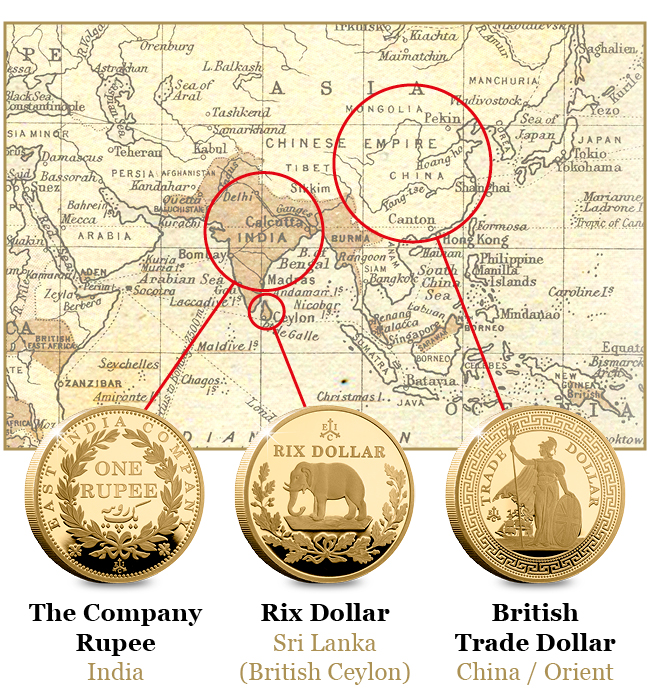
The Company Rupee – 1833 (India)
The Rupee is one of the world’s oldest systems of money. It was adopted by the East India Company upon its arrival in the East, and soon became one of the company’s most important coins and means for trade. In 1833 reforms to the Indian weights and measures led to coinage in India changing from the Sicca to the standard ‘Company Rupee’.
The Rix Dollar – 1821 (Sri Lanka)
Great Britain sought to develop Ceylon’s (Sri Lanka’s) economy and increase trade to and from Europe. As a part of this aim The Rix Dollar was struck specifically for use in Ceylon. Designed by Benedetto Pistrucci, who is also responsible for the now iconic rendition of St. George slaying the Dragon which features on British Sovereigns.
The British Trade Dollar – 1839 (The Orient)
To facilitate the trade of their most lucrative commodities, namely tea and opium a trading post in Canton, China was established. During the Trade Wars Great Britain found itself having to rely more and more on its own silver coinage, and this paved the way for one of the most distinctive silver British coins in numismatic history to be struck: the British Trade Dollar.
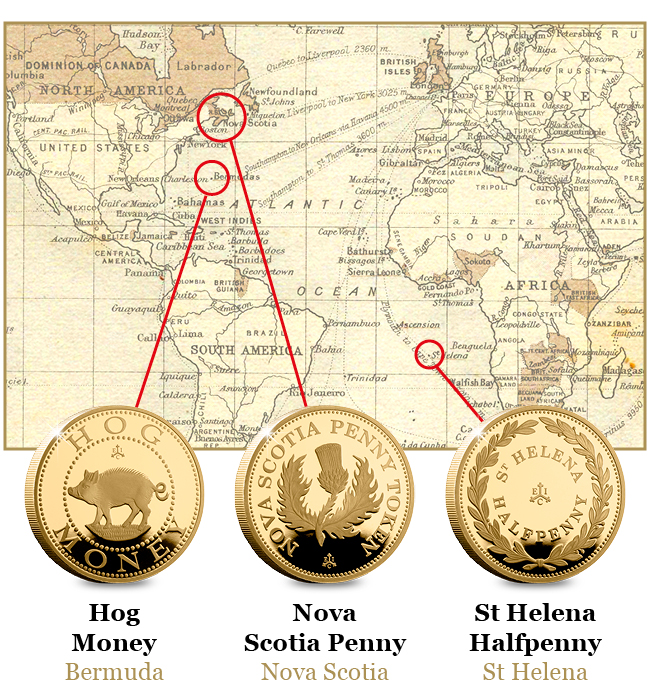
Hog Money – 1609 (Bermuda)
In order to develop Bermuda’s prosperous economy King James I granted permission to mint coins, which resulted in the issuing of Hog Money, inspired by the wild hogs previously introduced to the island, it’s the first English coin to be minted specifically for use in North America.
The St Helena Halfpenny – 1821 (St Helena)
In 1815 St Helena’s economy benefited from the arrival of the former French Emperor, Napoleon, during his second exile, as the famous prisoner brought with him an entourage of British troops, effectively doubling the islands population and prosperity. As the economy swelled, St Helena’s first local coins were introduced.
The Nova Scotia Penny – 1823 (Canada)
Prior to the Canadian Confederation in 1867 many provinces issued their own coinage. However in 1823, without seeking official approval from the Home Office, the province of Nova Scotia ordered the issuing of coins. The coins, issued in denominations of one pennies and halfpennies, contributed to the expansion of local commerce in Nova Scotia.
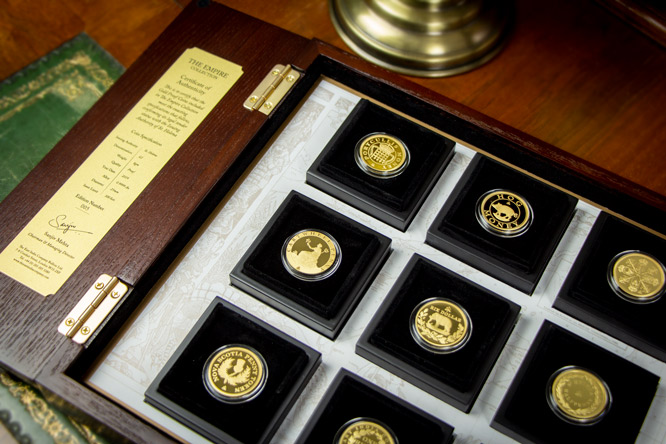
The 2019 Empire Collection
For this exceptional 2019 issue collectors will be taken on a journey to the far flung corners of the world. Retracing the steps of the East India Company, to discover some of the most significant coins which have helped build an empire stretching across three centuries from 1600 to the Victorian Era.
Finished to an exceptionally high standard, the 2019 collection truly represents the global resonance of The East India Company and these significant coins. There is no doubt the 2019 Empire Collection is going to become a future collector priority.
If you are interested…
Out of a Worldwide edition limit of just 100 we have a small stock of the 2019 Empire Collection available. If you are interested in owning a set – please complete the form below and we will contact you directly.
Your message has been sent

